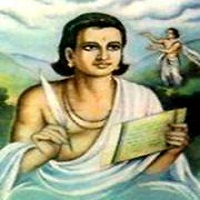Kalidasa (active late 4th-early 5th century) was classical India’s master poet and dramatist. He demonstrated the expressive and suggestive heights of which the Sanskrit language is capable and revealed the very essence of an entire civilization.
Nothing is known with certainty about the life of Kalidasa. Clearly later than the great Buddhist poet Asvaghosha (1st century), Kalidasa was celebrated as a major literary figure in the first half of the 7th century (the Aihole inscription, 634). The scholarly consensus outside India is that Kalidasa flourished in the time of Chandragupta II (reigned 380-413). A traditional Indian view would have it that he adorned Vikramaditya’s court in the 1st century B.C. Although he was especially fond of the Gupta capital city, Ujjain (about 30 miles north of Indore in west-central India), there is no proof that he was born there. Kalidasa was a devotee of Siva, but there is no trace of sectarian narrowness in his writings.
Just as it is impossible to write Kalidasa’s biography, it is impossible to establish the order in which his works were composed or to show development therein. Six major works are important. The epic poem Kumarasambhava (Birth of Kumara; Kumara, the Prince, was the war-god son of Siva) boldly recounts the divine romance that led to the birth of Siva’s son. Another epic poem, the Raghuvamsa, praises the origins and life of Rama. The cantos devoted to Rama show Kalidasa’s brilliant condensation and modulation of the Valmiki Ramayana. A comparison of the two poets is inevitable, and Kalidasa does not suffer. His Rama exhibits a depth of near-tragic heroism unparalleled in Sanskrit literature.
The lyric “elegy” Meghaduta (Cloud Messenger) is a short but striking work displaying another dimension of Kalidasa’s genius. This masterpiece tells of an exiled demidivinity who, in his anguish for the well-being of his bride, commissions a monsoon thunderhead to carry news of his safety to her in the north. This work is the fount of an enormously productive genre in Sanskrit and related Indic literatures. (The Meghaduta alone drew 45 commentaries, more than any other Sanskrit composition.)
As love stories, Kalidasa’s three dramas are not unusual, but the author’s control of dialogue, situation, and detail is masterly. Though the Malavikagnimitra is assumed to be the earliest of Kalidasa’s dramas, it is not an immature work. It is less satisfying than the other two because of its story. The Vikramorvasiya’s theme of the love of the human king and the divine nymph has greater potential for high pathos and even tragedy, and, for the most part, Kalidasa again takes advantage of the subject matter. The king’s love-madness in Act IV is depicted with unsurpassed lyric brilliance. Some critics have been offended that the play carries beyond the “natural tragic climax” to a happy ending; but it is in the poetry that its true grandeur lies.
Sakuntala in the Abhijnanasakuntalam is India’s most famous heroine. The prototype is found in the Mahabharata, but the great Sakuntala is the creature of Kalidasa. This drama is justly the most renowned of Kalidasa’s, for here poetry and drama become indissolubly one. There is order, delicacy, serenity, cohesion, and balance. It is appropriate that this was the literary work that first introduced India to Europe in modern times. All that Sanskritic culture was, its celebration of the real, and its conception of itself were epitomized in this drama fashioned by the culture’s greatest spokesman and poet.


No comments yet.